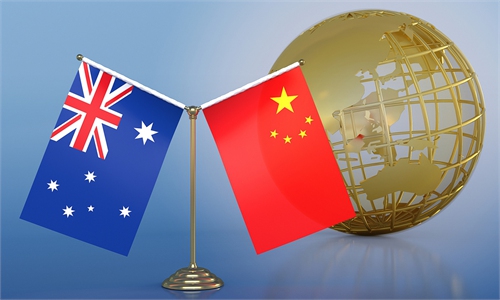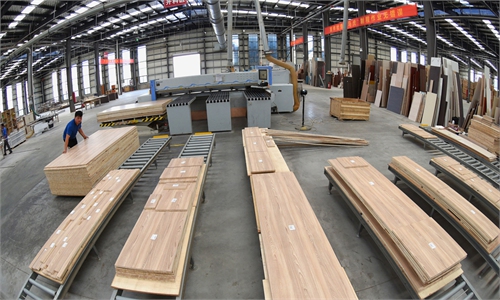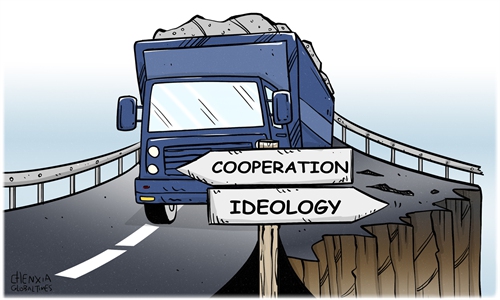China, Australia in partnership to explore green hydrogen after resumption of high-level economic dialogue
Mutual efforts to bring long-term boon: expert

This aerial photo taken on Dec. 15, 2022 shows public buses being refueled at a hydrogen refueling station in Lingang new area of Pudong New Area in east China's Shanghai.(Photo: Xinhua)
Businesses from China and Australia are stepping up exchanges in green hydrogen, a promising emerging energy source, after the two countries resumed high-level economic dialogue in May as bilateral ties improved under the Albanese government.
Chinese experts said on Sunday that hydrogen, a green energy source, has huge growth potential and success can be expected from a partnership between China and Australia.
Li Chunlin, deputy head of the National Development and Reform Commission, met with Andrew Forrest, founder and executive chairman of Australian mining giant FMG, on Friday.
Li told Forrest the commission will continue to support companies from both countries, including FMG, to engage in commercial cooperation on equal, friendly and mutually beneficial footing. Foreign companies including Australian firms are welcome to take part in China's hydrogen development, Li said.
Forest said FMG is willing to work with Chinese partners to promote green energy resources.
Iron ore billionaire Forrest is an activist in spearheading hydrogen development. A unit under FMG plans to build up an annual capacity of 15 million tons of green hydrogen by 2030. Green hydrogen means hydrogen derived from electricity generated from green and renewable energy such as wind and solar power.
In March, his company, the world's No.4 iron ore producer, signed a deal with Central China's Hunan Province on supply chain cooperation of green energy exploration.
Companies from Hunan's Zhuzhou and Changde, two industrial cities, will play a vital role in supplying companies including FMG with one-stop and integrated services including hydrogen equipment.
Australian companies are taking a pragmatic approach in procuring from Chinese suppliers, Lin Boqiang, director of the China Center for Energy Economics Research at Xiamen University, told the Global Times on Sunday.
"China's green hydrogen equipment may not be the best in the world but in terms of cost effectiveness, it's second to none. From this point, we can say Australia's path to transit to green energy is more sincere than others entities, such as the EU and the US, which had tariffs on new-energy products," Lin said.
FMG is not alone. Executives with Shanghai-based Hyfun, a hydrogen infrastructure provider, met with Australian Ambassador to China Graham Fletcher and the Australian side expressed strong interest in Hyfun's magnesium-based solid-state hydrogen storage solution, according to the company's WeChat account on May 31.
"China and Australia are highly complementary in green energy development with regard to technology, market demand and supply," Song Wei, a professor at the School of International Relations and Diplomacy, Beijing Foreign Studies University, told the Global Times.
A study by the Australian Renewable Energy Agency expects demand for hydrogen exports from Australia to top 3 million tons a year by 2040, worth $10 billion a year.
However, Lin said if Australia wants to export green hydrogen to China, it needs to fix cost issues rising from production and transportation.
China is a very competitive green hydrogen producer and Australian hydrogen must be at least in the same price range if it wants to explore the Chinese market, Lin noted.
"Bilateral cooperation between China and Australia on hydrogen is a boon for bilateral ties, while helping curb global climate change," Zhou Fangyin, a professor at the Guangdong Research Institute for International Strategies, told the Global Times on Sunday.
"It is also a type of cooperation that takes years, meaning the boon will also be long-term," Zhou said.
China's hydrogen energy sector has entered the fast lane of development. As the world's largest hydrogen producer, China has an annual hydrogen energy output of about 33 million tons.
A plan on the sector's development for the 2021-2035 period, released in March, called for hydrogen production from renewable energy to reach annual 100,000-200,000 tons by 2025. Carbon dioxide reductions will reach 1-2 million tons per year.
On Thursday, South Korea's Hyundai completed its first overseas hydrogen fuel cell battery plant in Guangzhou, South China's Guangdong Province. The initial phase of the plant, completed in less than three years, has a designed annual production capacity of 6,500 sets.



